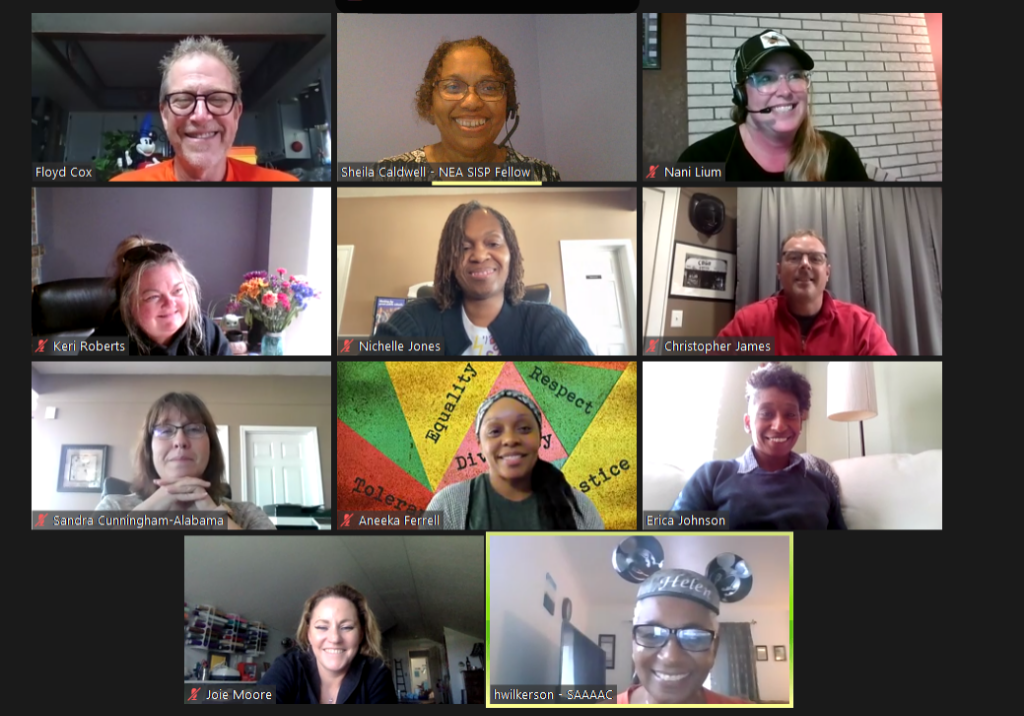By Sheila Caldwell, BSN, RN, CSN-NJ
I listen closely and hear that the music has taken on a different flow. The rhythm is a bit more steady with a smoother beat. As I reach for my jazz dancing shoes, I converse with the choreographer and dance team. The choreographer and dance team give me some tips about the pace and moves for this dance set. The dance has shifted, and we are moving in a synchronized fashion. Picking up on the cues of our team members and if in tandem, knowing those swing turns.
More settled into the position of SISP Fellow, I have gotten to interact with all the members of the ESPQ team as well as with other members of NEA. This month started off by the team wanting to learn more from me about the Health and Student Services Career Family, of which, nurses, who work in schools, are included. If you are not familiar with the NEA Career Families, you can learn more by clicking here.
The average person does not understand the complexities in nursing, let alone school nursing. It was a detailed presentation that lent way to discussions around some of the other career families. But, nurses, who work in schools, are in the unique situation of having two distinct regulatory agencies, not necessarily being included in regulation in some states and in most cases working autonomously in a school. There are many aspects of our role that are truly not understood, which leads to misunderstandings and misuse of our expertise. Even in the space of collective bargaining units, there is confusion because of the complexities of our specialty.
This presentation was well received and recognized as a catalyst to lift up nurses who work in schools. I do have to mention that there are specific reasons why I did not say “school” nurses and if you are interested in why, you can always reach out to me.
As for the real work in the fellowship, I have been brought into more national conversations and initiatives to add the voice of school nursing and school health. Collaborating with team members, reviewing documents for health information inclusion, joining committees that didn’t have a person with health background although we know—and the pandemic has truly heightened this—that health and wellness are vital to education. Learning cannot take place when staff and student health and wellness are not secure and supported.
One of the committees to which I have been invited is the NEA IDEA Cadre.
The NEA’s recently formed IDEA Cadre is a group of nearly two dozen educators with expertise from various special and general education disciplines from diverse geographic, demographic, professional and paraprofessional backgrounds. The IDEA Cadre works collaboratively to identify and respond to current and emerging issues through the creation of resources and trainings to support our membership and the students they serve. Click here to learn more.
I have only attended one IDEA Cadre meeting but do see its value and have been pondering how I see my school nursing voice being interjected. The work is rich and quite extensive as you can imagine when it comes to looking at Individuals with Disabilities Education Act or as the NEA IDEA Cadre website notes, “Invisible Disabilities.” With nursing services being an integral part of related services for students with disabilities, it only makes sense that nurses are included in all conversations in schools considering the vast array of diagnoses children may have. I plan to lean my knowledge to this group.
To round out this month, I was given the opportunity to attend the True Colors training and now am a Certified True Colors Facilitator. This unique experience walks you through a series of presentations on self-discovery to recognize your personal strengths and talents. It also provides insight to the dynamics of how a team or members in a group or work environment complement, or don’t complement, each other. Deep insights into relationships and project work can be better understood when one learns their own as well as their colleagues’ “True Colors.”
This was really telling for me personally and as I went through the training, a color that I thought was my brightest, turned out not to be. As we delved deeper into the training, it made sense. and I could really see that my characteristics were more of the one particular color than the one I first believed. It truly is a training that every educator should consider attending.
So, as I continue to dance, the steps are getting easier, the choreographed scores more solid and the music is becoming more familiar. I just want to leave you with this quote:
“When you dance, your purpose is not to get to a certain place on the floor. It’s to enjoy each step along the way.”
– Wayne Dyer
Until next month.
Sheila Caldwell, BSN, RN, CSN-NJ
Sheila Caldwell is a certified school nurse in the Matawan Aberdeen Regional School District. She is on leave to participate in the SISP Fellowship described in this article. In addition to receiving numerous national and local awards, Caldwell has received the American Academy of Pediatrics-NJ Chapter School Health Advocate of Year (2016) and the 2021 National Association of School Nurses (NASN) Recognition Award for “continued support and unique contributions to NASN and school nursing.”
Caldwell can be reached at SCaldwell@nea.org.
